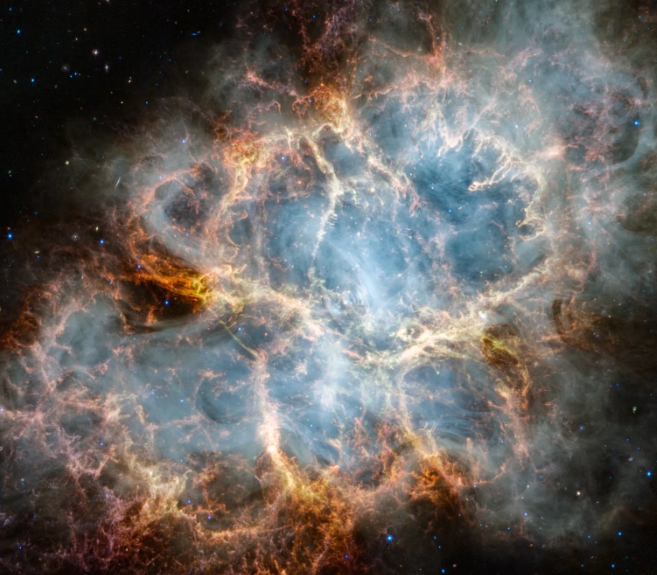NASA's James Webb Space Telescope has turned its infrared eyes towards the Crab Nebula, a supernova remnant situated 6,500 light-years away in the constellation Taurus.
This celestial event was initially recorded by astronomers in 1054 CE. Since then, the Crab Nebula has captivated scientists, serving as a crucial subject for comprehending the dynamics, behavior, and aftermath of supernovae.
Origins of the Crab Nebula
Under the guidance of Tea Temim at Princeton University, a team has utilized Webb's NIRCam (Near-Infrared Camera) and MIRI (Mid-Infrared Instrument) to probe into the origins of the Crab Nebula.
"Webb's sensitivity and spatial resolution allow us to accurately determine the composition of the ejected material, particularly the content of iron and nickel, which may reveal what type of explosion produced the Crab Nebula," Temim said.

Upon initial examination, the overall configuration of the supernova remnant mirrors the optical image initially unveiled by NASA's Hubble Space Telescope in 2005.
Webb's infrared scan reveals a distinct cage-like structure of ethereal gaseous strands painted in red-orange hues. Moreover, within the central zones, Webb exposes the emission from dust grains, displaying shades of yellow-white and green for the first time.
The inner workings of the Crab Nebula come into sharper focus and exhibit heightened accuracy within the infrared spectrum captured by Webb. Specifically, Webb illuminates the phenomenon known as synchrotron radiation: the emission originating from charged particles, such as electrons, swiftly traversing along magnetic field lines.
This radiation takes on the appearance of a milky, smoke-like substance, pervading a significant expanse of the Crab Nebula's nucleus.
Pulsar Nucleus
To pinpoint the pulsar nucleus nestled at the core of the Crab Nebula, NASA noted that one can track the delicate formations that adopt a circular ripple-like pattern leading towards the luminous white focal point at its center.
Extending further from this core, slender white bands of radiation guide the way. These wisps cluster closely, outlining the arrangement of the pulsar's magnetic field, a force that sculpts and shapes the nebula.
Moving towards the center left and right, the white substance gracefully curves inward from the edges of the filamentary dust framework, converging towards the neutron star's precise location. It appears as though the waist of the nebula has been cinched.
This sudden narrowing may be attributed to the compression exerted by a region of dense gas on the expansion of the supernova wind, according to NASA. The forceful wind propelled by the pulsar nucleus maintains its vigor, relentlessly pushing the shell of gas and dust outward at an impressive pace.
Within the remnant's interior, filaments in shades of yellow-white and green combine to form expansive loop-like structures, indicating regions inhabited by dust particles.
The quest for insights into the Crab Nebula's history remains ongoing as astronomers delve deeper into the Webb data and reference past observations of the remnant collected by other telescopes.
Additionally, scientists anticipate new data from Hubble within the next year, marking its first reexamination of the Crab Nebula's emission lines in over two decades. This will enable astronomers to conduct a more precise comparative analysis between the findings of Webb and Hubble.
Related Article : NASA's James Webb Space Telescope Captures a Cinematic Supersonic Outflow of Young Star

ⓒ 2025 TECHTIMES.com All rights reserved. Do not reproduce without permission.




